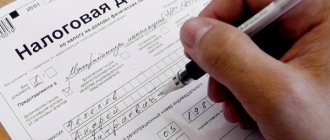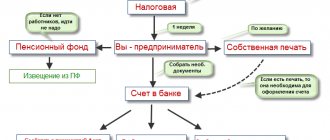After registering an individual entrepreneur with the tax office, you not only receive the right to conduct business, i.e. engage in entrepreneurial activity, but also have responsibilities, the first of which are to submit reports and pay insurance premiums for yourself. In addition to these key responsibilities of each individual entrepreneur, there are a number of nuances that you should know about so as not to run into fines in the first month of your official activity. Especially for this article, we have selected seven important issues that an IT freelancer needs to solve immediately after state registration.
And for those who have opened an LLC, we have prepared: 10 things that must be done after registering an LLC
Choose the right tax system
If, when you registered as an individual entrepreneur, you did not submit notifications about the transition to a simplified taxation system, then you will need to decide on the taxation system within the specified period of time after the date of registration.
The taxation system is the procedure for calculating and paying taxes. Each system has its own rate and tax base, but the main thing is that the amount of tax payable differs significantly. One such illustrative example is in the article “How much does a programmer earn in Moscow according to the Federal Tax Service.”
There are five taxation systems in total, but one of them (Unified Agricultural Tax) is intended only for agricultural producers. You can choose between the main one (OSNO) and special systems (USN, UTII, PSN). In principle, calculating the tax burden is an accounting topic, so if you know a competent specialist, then it makes sense to contact him.
You can also calculate something on your knee:
- for OSNO you have to pay 13% of the difference between income and expenses plus VAT;
- under the simplified tax system, income tax will be 6% of income (in some regions the rate can reach 1%);
- under the simplified tax system Income minus expenses - from 5% to 15% of the difference between income and expenses (in some regions the rate can reach up to 1%);
- the cost of the patent is given by the Federal Tax Service calculator;
- Calculating UTII is a little more complicated, but you can really do it on your own.
If you don’t want to delve into the calculations, and you can’t get to an accountant, we recommend that you apply for the simplified tax system for Income, because This is the most common tax system. Plus, it is the simplest reporting system with a fairly low tax burden. It can also be combined with any other systems except OSNO.
(!) There is an exception to our recommendation to immediately switch to the simplified tax system - if your main customers are budget organizations or large businesses, then they just need an individual entrepreneur working on OSNO.
Why is this important : special (aka preferential) tax regimes allow you to reduce payments to the budget to a minimum. This right is enshrined in Article 21 of the Tax Code of the Russian Federation. But if you yourself do not submit an application to switch to the simplified tax system, UTII, PSN, then no one will persuade you. By default, you will have to work on a common system (OSNO). It is not advisable to forget about the reporting deadlines of your system; tax authorities will very quickly block the current account of an individual entrepreneur for failure to submit a declaration.
Another reason to submit tax reports on time is the risk of receiving a payment from the Pension Fund in the amount of 154,852 rubles. The logic is this: since you have not reported your income to the Federal Tax Service, then its size is simply immodest. This means that contributions will be calculated at the maximum (8 minimum wage * 26% * 12). This is not a fine, the money will go to your pension account and will be taken into account when calculating your pension (if everything has not changed again by then), but still the surprise is not the most pleasant.
Entrepreneurship
An individual entrepreneur is a citizen who is registered with the tax authority for the purpose of further conducting business activities. In order to register, he needs to fill out an application and submit it to the Federal Tax Service at the place of registration in the passport - this can be done in person or on the tax office website. The application must indicate the taxation system under which the individual entrepreneur intends to operate. The following options are possible here:
- General taxation system
(OSNO). This is a standard tax regime that is automatically assigned to all entrepreneurs when they open an individual entrepreneur. Under the general regime, there are no restrictions - neither on types of activities, nor on the number of employees, nor on the amount of income. Individual entrepreneurs on OSNO pay value added tax (VAT) - in most cases 20% (for some goods there is a preferential rate of 10% and 0%), personal income tax (13% of profit) and property tax.
- Simplified taxation system
(USN, or “simplified”). This is a special tax regime that an individual entrepreneur can switch to by sending a notification to the Federal Tax Service. Individual entrepreneurs using the simplified tax system pay only one tax: 6% of all income or 15% of profit (the difference between income and confirmed expenses).
- Patent system
. This special regime can be applied for by individual entrepreneurs who conduct certain types of activities. In simple terms, a patent is a fixed amount that entrepreneurs pay for the opportunity not to pay all other taxes. This amount is calculated based on the potential annual income of the individual entrepreneur - and therefore depends on the type of activity and region. You can find out the cost of a patent using the calculator on the Federal Tax Service website.
- Unified agricultural tax
(ESKHN). This is a tax for producers of agricultural goods. The tax is calculated as follows: the tax base (income minus expenses and losses of previous years) is multiplied by the tax rate (each region sets its own rate; maximum - 6%).
- A single tax on imputed income
(UTII). Valid for certain areas of individual entrepreneur activity and not in all regions (for example, in Moscow you cannot switch to this mode). To calculate UTII, a special formula is used: individual entrepreneurs pay tax not on actual income, but on the income expected by the state in this area. The tax rate differs from region to region and can range from 7.5% to 15%.
Individual entrepreneurs have restrictions not only on types of activities, but also on turnover and the number of employees hired - they depend on the chosen taxation system.
STS (simplified taxation system)
Entrepreneurs under the simplified tax system should receive no more than 150 million rubles per year. After exceeding this amount, the individual entrepreneur loses the right to apply preferential treatment. There are also restrictions on the number of employees: no more than 100 people.
Patent
Entrepreneurs who work on the patent system are allowed to make a profit of no more than 60 million rubles per year and hire no more than 15 employees.
Take advantage of tax holidays
If you register as an individual entrepreneur for the first time after the adoption of the regional law on tax holidays, you can qualify for a zero tax rate under the simplified tax system and the special tax regime. You can avoid paying taxes for a maximum of two years. Specific types of activities for which tax holidays are established are determined by regional law.
In Moscow, individual entrepreneurs-developers are not entitled to tax holidays, but if your activities are related to scientific research and development, then in most regions, including Moscow, you can receive a zero tax rate.
Tax holidays in detail, as well as the basis of most regional laws, can be found here.
Why is this important: if there is an opportunity to end up in a tax haven for some time, why not take advantage of it? In addition, on PSN, in principle, there is no way to reduce the cost of a patent by the amount of contributions. And during the tax holiday, an individual entrepreneur’s patent will not cost you anything.
Know and pay your own insurance premiums
Insurance premiums are payments that every entrepreneur is obliged to make for himself to the pension fund (PFR) and the compulsory health insurance fund (MHIF). Starting from the new year, the Federal Tax Service will collect contributions, because... According to the authorities, the funds themselves do a poor job of collecting payments in their favor.
The minimum contribution amount changes every year. In 2020, this is about 23 thousand rubles plus 1% on income over 300 thousand. If you have been registered as an individual entrepreneur for less than a year, the amount is recalculated accordingly. You must pay your own contributions the entire time you are registered as an entrepreneur. Justifications and arguments of the form:
- I don’t conduct any real activities;
- What kind of business is there, only losses;
- The employer pays my contributions according to my work book;
- I’m actually retired already, etc.
funds are not accepted for consideration.
You can avoid paying contributions for yourself if the individual entrepreneur has been drafted into the army or he is caring for a child under one and a half years old, a disabled child, a disabled person of the 1st group, or elderly people over 80 years old. But even in these cases, the accrual of contributions does not automatically stop; you must first provide documents that you are not engaged in real business.
So it’s not worth opening an individual entrepreneur just like that, with the expectation that it might come in handy someday. If you nevertheless registered as an individual entrepreneur, but are now in downtime, then it is cheaper to deregister (the state fee is only 160 rubles), and, if necessary, register again. The number of approaches to the reception desk is not limited.
Why is this important: contributions will still be collected from you, even if you close the individual entrepreneur.
Plus, a fine of 20% to 40% of the unpaid amount and penalties will be charged. In addition, by not paying your contributions on time, you deprive yourself of the opportunity to immediately reduce the accrued tax by this amount. An example of reducing payments under the simplified tax system for insurance premiums
of an individual entrepreneur without employees using the simplified tax system. Income for 2020 earned 1 million rubles. He had no business expenses (but even if he had, no expenses are taken into account for the simplified tax system for income).
Tax amount 1,000,000 * 6% = 60,000 rubles. Individual entrepreneurs' insurance premiums for themselves amounted to 30,153.33 rubles, based on:
- contributions to the Pension Fund - (6,204 * 12 * 26%) + ((1,000,000 – 300,000) * 1%) = (19,356.48 + 7,000) = 26,356.48 rubles.
- contributions to the Compulsory Medical Insurance Fund - 3,796.85 rubles based on (6,204 * 12 * 5.1%) at any level of income.
The entrepreneur took advantage of the right to reduce advance payments for the single tax on the simplified tax system at the expense of paid insurance premiums, so he paid them quarterly (*).
Let's calculate the total amount that went to the budget in the form of tax: 60,000 - 30,153.33 rubles (the amount of insurance premiums paid by which the tax can be reduced) = 29,846.67 rubles. As a result, his entire tax burden, including insurance premiums, is equal to 60,000 rubles. The net income from the business of an individual entrepreneur is 1,000,000 – 60,000 = 940,000 rubles.
(*) If you pay contributions in a lump sum at the end of the year, you will first have to pay the full tax amount of 60,000 rubles, and then submit an application to the Federal Tax Service for a refund or offset of the overpaid tax. Therefore, it is better to pay contributions in installments every quarter and immediately reduce quarterly advance payments under the simplified tax system. The result will be the same, but in the first case there will be more trouble.
Taxation of individual entrepreneurs (brief overview of special regimes)
IP on OSNO
Option 1 (general taxation system) applies if the individual entrepreneur has not switched to one of the “special ones”.
regimes" (STS, UTII, Patent) In this case, the Individual Entrepreneur pays Personal Income Tax "NDFL" 13%, Value Added Tax "VAT" 18% or 10%, Property Tax, and accordingly, keeps records and submits reporting on these taxes. This system is the least convenient and is suitable only for large entrepreneurs, importers, and if there are profitable clients on OSNO with VAT. These are the main distinguishing features of individual entrepreneurs in the General Taxation System.
IP on simplified tax system 6%
Option 2 (simplified taxation system, income).
In our opinion, this is the best option, if, of course, it suits your business. Used for various services and/or at low cost/expenses.
The main tax is the Unified Tax of the simplified tax system of 6% on the income of individual entrepreneurs, replacing the above taxes. In other words, all revenue received by a bank account or the cash register of an individual entrepreneur is subject to taxation. You cannot reduce revenue by expenses incurred.
However, the amount of calculated tax may be reduced:
- for 100% of the mandatory payments (contributions) of an individual entrepreneur to the Pension Fund of the Russian Federation and the Federal Compulsory Medical Insurance Fund in a fixed amount. In 2013, these payments amounted to 35664.66/year. The amount and procedure for paying contributions in 2014, 2020, 2020 and 2020 are indicated at the end of the material. This deduction applies if the individual entrepreneur has no employees.
or, if the individual entrepreneur uses the labor of hired workers:
- 50% of payments (contributions) to the Pension Fund, Compulsory Medical Insurance Fund, Social Insurance Fund accrued and paid for employees.
Income is recorded in the Income and Expense Accounting Book “KUDiR” for individual entrepreneurs using a simplified taxation system. Cash transactions and accounting of fixed assets “OS” are carried out in the general mode. We also note that there is no need to maintain accounting records and no additional taxation of the resulting profit. Free funds remaining after paying the Single Tax can be issued from the cash register or transferred to a personal card from a current account; such payments are not subject to personal income tax. An additional advantage is the simplicity of accounting and reporting, as well as the lack of interest in inspections by tax authorities.
IP on simplified tax system 15%
Option 3 (simplified taxation system, income minus expenses).
This option is suitable for trade and/or in case of high costs/expenses. Also, if the cost of the product is high and the markup is small.
The main tax is the Unified Tax of the simplified tax system of 15% on the income of an individual entrepreneur, reduced by his expenses. In this case, expenses must be justified, economically justified and documented. The list of expenses by which income can be reduced is prescribed in Article 346.16 of the Tax Code of the Russian Federation. The list is closed, i.e. You can only take into account those expenses that are directly prescribed by law.
Income and expenses are accounted for in the Income and Expense Accounting Book “KUDiR”. Cash desk and OS - according to the general rules. Accounting may not be maintained. Profit is paid without additional taxation.
In this option, accounting is somewhat more complicated and the attention of the tax authorities may be more careful, since it will be necessary to confirm the validity of the expenses incurred.
IP on Patent
4-option (patent taxation system). A new type of special regime has been included in a separate chapter of the Tax Code since 2013, but for local action the law of the subject of the Russian Federation is additionally required. In the Moscow region there is a law “On the patent taxation system in the territory of the Moscow region”. In the federal city of Moscow, Law No. 53 “On the Patent Taxation System” was adopted. You can download the full text of these regional laws on our website. Only individual entrepreneurs can obtain a Patent; organizations are deprived of this right.
A patent can be applied along with other regimes and apply to certain types of activities established by law. Basically, these are various services, as well as retail trade in halls up to 50 sq.m. A patent is valid for one type of business activity in the territory of one subject of the Russian Federation; in the territory of another subject of the Russian Federation, a new Patent must be obtained for each type of activity.
You can apply for a patent simultaneously with the opening of an individual entrepreneur or 10 days before the start of application of the Patent Tax System.
A patent replaces basic taxes and also exempts you from the obligation to submit a declaration. The object of taxation is the “potentially receivable annual income of an individual entrepreneur” for each type of activity, and is established by the law of the subject of the Russian Federation.
For example, a Patent for trade in a hall with an area of no more than 50 square meters in the Moscow region for the full year 2020 will cost:
- 12,528 rubles/year for individual entrepreneurs without employees;
- at 30,210 rubles/year for individual entrepreneurs from 1 to 3 employees;
- at 253,888 rubles/year for individual entrepreneurs from 4 to 15 employees;
The average number of employees of 15 employees under labor and civil law contracts is the maximum number of employees for obtaining and applying a Patent.
We can say that the Patent is a very attractive regime for small businesses, suitable for Entrepreneurs without employees and with a small number of employees. In relation to Moscow, from July 2020, the benefits of applying the Patent System in relation to trade activities are enhanced by the exemption from paying the Trade Tax.
Trade fee
A new type of additional local tax based on the object of trade activity. Currently valid from 07/01/2015 in Moscow. See our Trade Fee review for more details.
IP on UTII
Option 5 (single tax on imputed income). UTII - is put into effect by the laws of the constituent entities of the federation. In particular, individual entrepreneurs in Moscow do not have the opportunity to use it at all, but UTII in the Moscow region is valid and can be a good alternative to other regimes. Since 2013, the transition to the Single Tax has become voluntary. Now the Entrepreneur must decide for himself: to switch to UTII or not. In a specific situation, depending on the type of activity, this may be more or less profitable in contrast to other options.
Pension contributions of individual entrepreneurs
In 2020, individual entrepreneur contributions increased to 27,990-00 rubles, plus 1% (one percent) of income exceeding the amount of 300 tr. for the tax period. Fixed contributions of individual entrepreneurs are paid regardless of the taxation system applied.
By opening (registering) an individual entrepreneur, an individual automatically becomes a payer of contributions to pension and medical funds. The amount due for payment of contributions is tied to the minimum wage. Therefore, it is different for every year. You can calculate it yourself, but it’s easier to check with the Pension Fund, and at the same time clarify the payment details, which may also change from the new year. And you must remember that the lack of activity of an individual entrepreneur and, as a consequence of this, the lack of income, does not exempt the individual entrepreneur from paying contributions.
Remember! A citizen who has the status of an individual entrepreneur stops paying contributions only from the moment of exclusion from the Unified State Register of Individual Entrepreneurs. Although there are exceptions to this rule. Clause 6 of Article 14 of Law No. 212-FZ lists the following cases:
- child care leave up to 1.5 years;
- military service by conscription;
- caring for a disabled person of group I, a disabled child or an elderly person who has reached the age of 80;
- living with a spouse of a military serviceman serving under a contract in an area where there is no employment opportunity;
- living abroad with a spouse sent to work at diplomatic missions and consular offices of the Russian Federation, international organizations.
To take advantage of the benefit, you need to write a statement about the suspension of the activities of an individual entrepreneur in connection with one of the points and submit it to the Pension Fund.
Payment of fees
You can calculate the amounts of fixed contributions of individual entrepreneurs for 2020 and 2020 in our: online fixed contribution calculator directly on the website.
In 2020, the amount of the total fixed payment (PFR and MHIF) of an individual entrepreneur is
- 27990 rubles 00 kopecks (and an additional 1% of revenue over 300t.)
it is distributed into two funds:
- The individual entrepreneur’s contribution to the Pension Fund for 2020 is equal to: 23,400.00 rubles.
- The contribution of individual entrepreneurs to the Compulsory Medical Insurance Fund for 2020 is equal to: 4590.00 rubles.
Not only have the BCCs for individual entrepreneurs changed since 2020, but also the administration of contributions has been transferred to the tax inspectorates.
- To pay fixed contributions to individual entrepreneurs in 2020, budget classification codes are used:
- KBK PFR 18210202140061110160 – up to 300 tons.
- KBK PFR 18210202140061110160 – 1% from excess of 300 tons.
- KBK FOMS 18210202103081013160
- KBK PFR 18210202140062110160 - penalties
- KBK PFR 18210202140062210160 - interest
- KBK PFR 18210202140063010160 - fines
and:
Federal Compulsory Medical Insurance Fund
- KBK FOMS 18210202103082013160 - penalties
- KBK FOMS 18210202103083013160 - fines
In 2020, the amount of the total fixed payment (PFR and MHIF) of an individual entrepreneur was 23,153 rubles 33 kopecks (and an additional 1% of revenue over 300 thousand)
In 2020, the total fixed payment was RUB 22,261.38. (plus 1% of revenue over 300t.)
From 2014 to the present, a new procedure for calculating and paying insurance premiums in a fixed amount for the self-employed population has been in effect. The amount of contributions is divided into two options depending on the amount of revenue of the entrepreneur for the tax period. The fixed amount must be paid before the end of the year (possibly in installments), and 1% until April 1 of the following reporting year, but it can also be paid during the year.
In 2014, fixed payments by individual entrepreneurs “insurance contributions in a fixed amount” to extra-budgetary funds (pension fund and compulsory health insurance fund) were:
The first option - for revenues of less than 300,000 rubles - the amount of the annual payment is 20,727.53 rubles. This amount must be paid regardless of income or business activity.
Calculation depending on the minimum wage (the formula is still valid):
- The minimum wage for 2014 is 5554 rubles. x 26% x 12 months = 17328.48 rub. (contribution to the Pension Fund)
- The minimum wage for 2014 is 5554 rubles. x 5.1% x 12 months = RUB 3,399.05 (contribution to the FFOMS)
The second option - with revenue of more than 300,000 rubles - the amount of the annual payment is 20,727.53 rubles. plus 1% of the amount exceeding 300 thousand rubles per year.
A limit has also been established for insurance contributions calculated from amounts exceeding three hundred thousandth of revenue; it is equal to eight times the size of the fixed contribution to the Pension Fund of the Russian Federation, i.e. RUB 138,627.84 The total maximum amount of fixed payments for individual entrepreneurs in 2014 will be: 142,026.89 rubles. The maximum contribution amount in 2020 is RUB 148,886.40. And the maximum amount of Pension Fund contributions in 2020 is 154,851.84 rubles.
In 2013, the total amount of contributions for the full year was 35,664-66 rubles. When transferring contributions to the Pension Fund, the following procedure for their distribution existed:
For persons born in 1967 and younger:
- 24984-00 rub. Insurance contributions in a fixed amount for the payment of the insurance part of the labor pension.
- 7495-20 rub. Insurance contributions in a fixed amount for the payment of the funded part of the labor pension.
- 3185-46 rub. Insurance premiums for compulsory medical insurance, credited to the FFOMS budget.
For persons born in 1966:
- 32479-20 rub. Insurance contributions in a fixed amount for the payment of the insurance part of the labor pension.
- 3185-46 rub. Insurance premiums for compulsory medical insurance, credited to the FFOMS budget.
Share useful information with your friends:
Free consultation on registration and taxes of individual entrepreneurs. Contact us at the bottom of the page, or in the group:
vk.com/fiogarant
Sincerely, lawyer of the Fiolent Legal Center, Anton Lysenkov
8 (for all questions)
Working hours: from 10 to 19, Mon-Fri.
To get a consultation
Submit notice of commencement of activity
Few people know this, but before starting to provide repair services for computers and communications equipment (OKVED codes 95.11 and 95.12), an individual entrepreneur must submit a notification of the start of business activity to the local branch of Rospotrebnadzor.
This is done in order to include you in the Rospotrebnadzor inspection plan, although they promise not to check you for the first three years after registration of an individual entrepreneur. But if a client complains about you, dissatisfied with the quality of services, then the inspection will be unscheduled. By the way, from January 1, 2017, Rospotrebnadzor will come with an inspection only if the client provides evidence that he has already tried to hold you accountable. Apparently, the department is already tired of checking the reality of all consumer complaints.
Why is this important: if you do not submit a notification, you can receive a fine of 3 to 5 thousand rubles. The mere indication of OKVED codes 95.11 and 95.12 when registering an individual entrepreneur does not oblige you to report anything. You only need to submit a notice if you actually plan to start repairing computers and communications equipment.
BUSINESS -
The official position of the Russian Ministry of Finance on this issue is as follows:
- if a patent has been obtained for a type of activity specified in paragraph 2 of Article 346.43 of the Tax Code of the Russian Federation, then entrepreneurs can work with legal entities. It does not matter how the payments are made, through a current account or in cash
- if a patent was received for a type of activity established by regional law, then under this patent entrepreneurs can work only with the population, and for working with organizations a different taxation regime should be applied
List of types of activities for which an individual entrepreneur can provide services to both individuals and legal entities (according to clause 2 of Article 346.43 of the Tax Code of the Russian Federation)
1) repair and sewing of clothing, fur and leather products, hats and textile haberdashery products, repair, sewing and knitting of knitwear
2) repair, cleaning, painting and sewing shoes
3) hairdressing and beauty services
4) dry cleaning, dyeing and laundry services
5) production and repair of metal haberdashery, keys, license plates, street signs
6) repair and maintenance of household radio-electronic equipment, household cars and household appliances, watches, repair and manufacture of metal products
7) furniture repair
 services of photo studios, photo and film laboratories
services of photo studios, photo and film laboratories
9) maintenance and repair of motor vehicles and motor vehicles, machinery and equipment
10) provision of motor transport services for the transportation of goods by road
11) provision of motor transport services for the transportation of passengers by road
12) renovation of housing and other buildings
13) services for installation, electrical, sanitary and welding works
14) services for glazing balconies and loggias, cutting glass and mirrors, artistic glass processing
15) services for training the population in courses and tutoring
16) services for supervision and care of children and the sick
17) services for receiving glassware and secondary raw materials, with the exception of scrap metal
18) veterinary services
19) leasing (renting) residential and non-residential premises, dachas, land plots owned by an individual entrepreneur by right of ownership
20) production of folk arts and crafts
21) other production services (services for processing agricultural products and forest products, including grain grinding, grain peeling, oilseed processing, production and smoking of sausages, potato processing, processing of customer-supplied washed wool into knitted yarn, dressing of animal skins, combing wool, grooming of domestic animals, repair and production of cooper's utensils and pottery, protection of gardens, vegetable gardens and green spaces from pests and diseases; production of felted shoes; production of agricultural implements from the customer's material; engraving work on metal, glass, porcelain, wood, ceramics ; production and repair of wooden boats; repair of toys; repair of tourist equipment and inventory; services for plowing gardens and sawing firewood; services for repair and production of eyeglasses; production and printing of business cards and invitation cards for family celebrations; bookbinding, stitching, edging, cardboard works; charging gas cartridges for siphons, replacing batteries in electronic watches and other devices)
22) production and restoration of carpets and rugs
23) repair of jewelry, costume jewelry
24) chasing and engraving of jewelry
25) monophonic and stereophonic recording of speech, singing, instrumental performance of the customer on magnetic tape, CD, re-recording of musical and literary works on magnetic tape, CD
26) residential cleaning and housekeeping services
27) residential interior design services and decoration services
28) conducting classes in physical education and sports
29) porter services at railway stations, bus stations, air terminals, airports, sea and river ports
30) paid toilet services
31) services of chefs for preparing dishes at home
32) provision of services for the transportation of passengers by water transport
33) provision of services for the transportation of goods by water transport
34) services related to the marketing of agricultural products (storage, sorting, drying, washing, packaging, packing and transportation)
35) services related to the maintenance of agricultural production (mechanized, agrochemical, reclamation, transport work)
36) services for green farming and decorative floriculture
37) management of hunting and hunting
38) engagement in medical activities or pharmaceutical activities by a person licensed for these types of activities
39) carrying out private detective activities by a person holding a license
40) rental services
41) excursion services
42) ritual services
43) funeral services
44) services of street patrols, security guards, watchmen and watchmen
45) retail trade carried out through stationary retail chain facilities with a sales floor area of no more than 50 square meters for each trade facility
46) retail trade carried out through objects of a stationary trading network that do not have trading floors, as well as through objects of a non-stationary trading network
47) public catering services provided through public catering facilities with an area of the customer service hall of no more than 50 square meters for each public catering facility;
48) public catering services provided through public catering facilities that do not have a customer service hall
49) provision of services for slaughter, transportation, distillation, grazing of livestock
50) production of leather and leather goods
51) collection and procurement of food forest resources, non-timber forest resources and medicinal plants
52) drying, processing and canning of fruits and vegetables
53) production of dairy products
54) production of fruit and berry planting materials, growing vegetable seedlings and grass seeds
55) production of bakery and flour confectionery products
56) commercial and sport fishing and fish farming
57) forestry and other forestry activities
58) translation and interpretation activities
59) activities for caring for the elderly and disabled
60) collection, processing and disposal of waste, as well as processing of secondary raw materials
61) cutting, processing and finishing of stone for monuments
62) provision of services (performance of work) for the development of computer programs and databases (software and information products of computer technology), their adaptation and modification
63) repair of computers and communications equipment
For all other types of activities (not listed in the above list), an individual entrepreneur can provide services only to individuals
Open a current account
You can work without a current account if your clients are individuals who pay in cash, and you enter into agreements with other individual entrepreneurs and LLCs for amounts not exceeding 100 thousand rubles. This is the limit that the Central Bank has set for cash payments between commercial entities.
It is quite easy to exceed it, because this is not a one-time payment, but the amount of settlements throughout the entire term of the contract. For example, you entered into a lease agreement for a year, the rent is 15 thousand rubles per month. The total amount of payments under the agreement will be 180 thousand rubles, which means that rent payment is allowed only by bank transfer.
Non-cash payments are, in principle, convenient, not only because they increase the number of payment methods, but also allow the consumer to pay you with a credit card when he has no other free money. Payments with electronic money can be legalized by creating a corporate wallet for individual entrepreneurs.
Why is this important: for violating the cash payment limit, individual entrepreneurs are fined under Article 15.1 of the Code of Administrative Offenses of the Russian Federation (from 4 to 5 thousand rubles). And we talked about why you shouldn’t accept payments to your personal card in the article 5 reasons not to use your personal account in freelancing.
Blog about taxes by Vladimir Turov
Is it possible to build a business solely on relationships with individual entrepreneurs: so that all, all, all former workers under the Labor Code of the Russian Federation will overnight turn into individual entrepreneurs. And the general director, and the chief accountant, and the salesperson, and the IT specialist, and the marketer? And even the cleaning lady...
And is it possible to pay millions to an invaluable individual entrepreneur for super-duper-high-quality services?
Moreover, in both the first and second cases, without bothering too much... Some businessmen still think this way and end up in the snares of the tax authorities.
4 in 1: when individual entrepreneurs are one whole
Tax officials came to an individual entrepreneur and accused him of artificially splitting his business in order to apply UTII. Additional personal income tax and VAT have been added. If only they hadn’t charged extra: it’s such an ignorant way to concoct a store...
The situation was as follows: the individual entrepreneur "Entrepreneur" leased retail space to two individual entrepreneurs "Accountants", who simultaneously work for him under the Labor Code of the Russian Federation, as well as to the individual entrepreneur "Manager". Moreover, the individual entrepreneur “Entrepreneur” himself was accepted to the position of director for the Labor Code of the Russian Federation from the individual entrepreneur “Accountants”... Perspicacious tax specialists in such a “confusing” scheme, in accordance with Article 20 of the Tax Code of the Russian Federation and Article 105.1 of the Tax Code of the Russian Federation , revealed interdependence.
Individual entrepreneurs worked together, engaged in trade, until they were recognized as a single whole. The complex relationship was united by a common business area:
- One sign for everyone;
- One entrance;
- Unified corporate identity;
- Unified ordering and delivery system;
- Some workers worked part-time for several entrepreneurs at once.
In addition, the individual entrepreneur “Accountants” used the cash register equipment of the individual entrepreneur “Entrepreneur”, and also used his property on the basis of lease agreements. The injured individual entrepreneur was the only supplier for them and bore all the exorbitant expenses for the three of them and controlled everything: expenses for security services, energy supply, water supply, heating supply, advertising, maintenance of the security alarm system, etc. In general, the absence of at least some hint of independence...
The court based on the Resolution of the Volga-Vyatka District Court dated May 25, 2017. in case No. A38-3486/2016, recognized the proceeds from the sale of goods of the individual entrepreneur “Accountants” and the individual entrepreneur “Manager” as income of the individual entrepreneur “Entrepreneur”, and confirmed the legality of additional accrual of personal income tax and VAT.
What did the would-be entrepreneur need to take into account in his relationship with individual entrepreneurs so that everything would go smoothly?
Natalia Bryleva
Lawyer and tax consultant at Turov and Partners:
- In this case, we are talking about the lack of independence of each separated entity.
To the above-mentioned signs of a single business, we can add: collection is established for one individual entrepreneur, and all interdependent individual entrepreneurs are collected, employees represent themselves on behalf of one company, use the same telephone numbers, including when submitting tax reports, one website. By excluding being tied to one individual entrepreneur, using your own funds to pay mandatory payments and declaring yourself as an independent business, you can protect yourself from such claims from tax authorities.
Undercover: when an individual entrepreneur cashes out
Another ill-conceived relationship with an individual entrepreneur. Impudence and formal paperwork became the reason for additional income tax assessment.
The company hired an individual entrepreneur as an expert “in the preparation, verification and technical execution of cargo documents, maintaining customs statistics regarding cargo.” In accordance with the agreement, the individual entrepreneur had to deal with various organizational and paperwork.
Tax officials declassified that the relationship was a “fake”, and this was indicated by the following facts:
- Customs declarations were signed by the company’s employees, and according to the agreement, the individual entrepreneur had to sign;
- Certificates of services provided in the form of completion and the name of the services provided are completely identical, are not detailed and do not contain data on the actual work performed, their volume and nature, deadlines for completion, place of provision of services, which does not correspond to the current procedure for preparing primary documents established by the Law “On Accounting”. accounting";
- The company could not explain how the individual entrepreneur's remuneration was calculated;
- The entrepreneur transferred more than 60% of the amounts received by the company to his plastic cards within 5 days and then cashed them out.
The society tried and tried to defend the relationship, but could not... So, for example, under newly clarified circumstances, the “logistics and customs specialist” was engaged in attracting clients and incurred the costs of moving and storing goods, but this could not be documented.
The court based on the Resolution of the Administrative Court of the North Caucasus District dated May 29, 2017. in case No. A53-14475/2015 recognized additional charges as legal.
Natalia Bryleva
Lawyer and tax consultant at Turov and Partners:
- These are the consequences of a neglectful attitude towards document flow, especially since the very nature of the services in most cases does not allow their provision to be confirmed by anything other than completed reports. Moreover, the reports must be filled out independently by the person who directly provides them. This way, the information will be stored in your head and during interrogation at the tax office, you will always be able to confirm your awareness of what and when you did under such an agreement.
A request to accountants: if you decide to use such a system in your company, be persistent and do not pay money even to the owner for services rendered until your accounting department has a report and an act - these are primary documents.
Exactly: when an individual entrepreneur works as per the Labor Code of the Russian Federation
On-site inspection. The tax authorities established that the number of employees of the company is 1 person (director of the company). The company carried out its activities exclusively with the help of hired individual entrepreneurs. Everything would be fine, because the law does not prohibit the conclusion of civil contracts, but in this case, tax authorities noted the similarity of the provision of services to individual entrepreneurs with the work of personnel under the Labor Code of the Russian Federation:
- Payments were made monthly on the 1st;
- “The subject of the contracts contains a clear indication of the specialty and profession - accountant, cashier, logistics manager, as well as the specific type of activity entrusted to the employee...”;
- “All contracts concluded by the company were not one-time, but systematic in nature: all contracts with individuals were concluded for a calendar year or until the end of the calendar year...”;
- Individual entrepreneurs worked from 9:00 to 18:00, with a lunch break from 13:00 to 14:00, and could leave the workplace only after notifying management.
And finally: “a condition for concluding contracts for the provision of paid services with individuals involved in the activities of the company was their registration as individual entrepreneurs. Upon termination of the relationship of providing services to society, individual entrepreneurs ceased their business activities and were deregistered.”
The court based on the Ruling of the Supreme Court of the Russian Federation dated February 27, 2017. No. 302-KG17-382 reclassified relations with individual entrepreneurs as labor ones and added additional personal income tax.
Natalia Bryleva
Lawyer and tax consultant at Turov and Partners:
- In addition to the correct drafting of an agreement with individual entrepreneurs without signs of an employment relationship, training of the employees themselves. After all, they must also understand why it is beneficial for them to switch to individual entrepreneurs. In addition, it is necessary to properly motivate the staff so that they do not give such testimony to the tax authorities: “I was asked to register by my employer.” I don’t want to hear about the risks that this former employee, an individual entrepreneur, may separate and subsequently compete with you. There are always risks in any optimization. It is only necessary to compare the risks of using legal optimization methods and their consequences with illegal ones using “fly-by-night” methods.
What to pay for as an individual entrepreneur: saving on taxes through services
At the free webinar “What to pay for as an individual entrepreneur: saving on taxes through services,” Natalya Bryleva will talk about which of the company’s employees can be outsourced and what needs to be taken into account.
Natalia Bryleva
Lawyer and tax consultant at Turov and Partners:
- Everything needs to be done in moderation: and transferring staff to individual entrepreneurs too. This is a long-term job: you cannot fire 5 employees in one day and immediately register them as individual entrepreneurs; do not make identical contracts. After all, each individual entrepreneur is now a counterparty for you and the terms of the relationship will differ, even by a percentage, from the conditions with another individual entrepreneur.
At seminars I am often asked the question: what services can an individual entrepreneur provide, and what should he be paid for? During the webinar we will look at the most used methods. Get ready to understand what percentage you can give to the individual entrepreneur: you will need the following indicators: total income for the period (how much came to the current account), renewable inventory (how much needed to be purchased to receive the above income, for services this indicator is usually zero , if not an expedition) and transportation costs of the involved organizations.
Let's calculate exactly how beneficial this is for you.
What shall we talk about?
- How can you use IP in business?
- Types of contracts with individual entrepreneurs;
- Examples of relationships with individual entrepreneurs;
- Ensuring security in collaboration.
SIGN UP FOR A FREE WEBINAR
(Visited 337 times, 1 visits today)
Natalia Nagornova
Editor-in-Chief of Vladimir Turov’s Tax Blog
Register as an insurer
If you use hired labor, you must register as an insurer in a timely manner. Moreover, the type of contract with the employee - labor or civil law - does not matter. Even if you enter into a one-time short-term contract for the performance of some services or work with an ordinary individual, you become the insured. That is, in addition to paying remuneration to the contractor, they are required to pay insurance premiums for him at their own expense, withhold and transfer personal income tax to the budget and submit reports.
The obligations of the policyholder to submit all kinds of reports on employees or performers are very depressing - there is really a lot of it, and it is complex. And since 2020, the main functions of administering contributions have been transferred to the Federal Tax Service, nevertheless leaving some reporting for the Pension Fund and the Social Insurance Fund.
Why is this important: the deadline for registering individuals as an insurer with the Pension Fund of the Russian Federation and the Social Insurance Fund is 30 days from the date of conclusion of the first employment or civil law contract. If you violate the deadline or do not register at all, the Pension Fund will fine you from 5 to 10 thousand, and social insurance – from 5 to 20 thousand rubles. Since 2020, the procedure for registering with the Social Insurance Fund remains the same, and instead of the Pension Fund of Russia, the application of an individual entrepreneur must be submitted to any tax authority.
Is the quality of legal activity regulated?
Attention! Permits for carrying out legal activities are not issued.
In the Federal Law of the Russian Federation “On Licensing”, adopted on May 4, 2011, No. 99 , there is no such requirement for organizations and individuals planning to engage in such practice and engaged in it.
In accordance with this, despite the high level of responsibility and significance of this type of work, obtaining a license for legal activity is not required either by organizations or representatives of the ordinary civilian population.
Permits for carrying out legal activities are not issued
Despite the absence of any legislative provisions, the qualitative parameters of this type of activity are regulated by legal acts. The general criteria used to evaluate services are the following:
- timeliness of assistance provided;
- relevance of current legislation;
- achieving results;
- protecting the interests of the client side.
Each element in the legal process is subject to regulation and regulation through the rules of procedural law.









